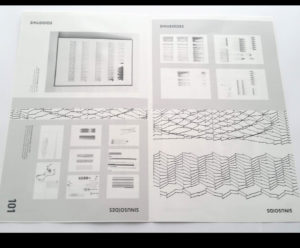FR/EN
Coding gone graphically wild
Coding to draw means choosing to re-examine current possibilities for graphic production. When and why to complete a graphic project? How do you draw a program? When and why take control? The graphic and algorithmic design approach puts individual mastery of graphic creation into perspective. You have to draw with data, tinker and darn the code, let yourself go to the intoxication of numbers and their unforeseen events, agree to let the program abandon itself to the calculation or to its crash when the result traps us. Ultimately, however, this form of creation questions the limits of the process of graphic emancipation and those of its aesthetic reception by the public.
Well publicized in Europe and the United States (museum institutions and foundations are dedicated to them), the graphic productions of generative drawing are not exhibited and unfortunately remain in France most often at the gimmick stage. They lack visibility and cultural, artistic and heritage recognition while they are part of an identifiable lineage, starting from Computer Art which, from the 60s and 70s, renewed experimental approaches to form and color with the irruption of the computer into the process of artistic creation.
The graphic wildness of the code traces a journey and a set of studies, graphic creations and texts leading a process of drawing research in a digital environment. The effects of the code and the materiality of the data of the generative drawing produced with a plotter manifest the symptom of an era of transition, of an unresolved form. The singularity of the drawing executed with a tracer on the sheet of paper acts as the production of concrete micro spaces which maintain the tangible link between the ancestral writing of signs and the digital code which now encrypts the affairs of the world.
Taking a critical look at the transition from drawing to graphic paths and its computational logics, I investigate the aesthetic interest of computer drawing by questioning it based on crossroads that I have traveled since the early 1980s. In a twisted way, I interrogate the data captured by the visualization in the design and manufacturing process of the machine drawing. How can code and graphic lines combine to produce new forms of emancipation? The aesthetic radicalism of generative, programmed, black and white drawing, plays with standards and goes beyond them by voluntarily producing almost nothing on the scale of a world worked by digitalization.
Présent Composé editions are hosted at the PTAC laboratory (Pratiques et théories des arts contemporains), Rennes 2
—————–
Coder pour dessiner, c’est faire le choix de réexaminer les possibilités actuelles de production graphique. Quand et pourquoi faire aboutir un projet graphique ? Comment dessine t-on un programme? Quand et pourquoi reprendre la main ? La démarche de conception graphique et algorithmique relativise la maitrise individuelle de création graphique. Il faut dessiner avec des données, triturer et repriser le code, se laisser aller à l’ivresse des nombres et à leurs imprévus, accepter de laisser le programme s’abandonner au calcul ou à son plantage quand le résultat nous piège. Au final pourtant, cette forme de création interroge les limites du processus d’émancipation graphique et celles de sa réception esthétique par les publics.
Bien médiatisées en Europe et aux États unis (des institutions muséales et des fondations leur sont dédiées), les productions graphiques du dessin génératif ne s’exposent pas et restent malheureusement en France le plus souvent au stade du gimmick. Elles manquent de visibilité et d’une reconnaissance culturelle, artistique et patrimoniale alors qu’elles s’inscrivent dans une filiation identifiable, à partir du Computer Art qui, à partir des années 60 et 70, renouvelle les approches expérimentales de la forme et de la couleur avec l’irruption de l’ordinateur dans le processus de création artistique.
L’ensauvagement graphique du code retrace un parcours et un ensemble d’études, de créations graphiques et de textes conduisant un processus de recherche en dessin dans un environnement numérique. Les effets du code et la matérialité des données du dessin génératif réalisé avec une table traçante manifeste le symptôme d’une époque de transition, d’une forme irrésolue. La singularité du dessin exécuté au traceur sur la feuille de papier agit comme la production de micro espaces concrets qui maintiennent le lien tangible entre l’écriture ancestrale des signes et le code numérique qui chiffre désormais les affaires du monde.
Portant un regard critique sur la transition du dessin vers les parcours graphiques et ses logiques computationnelles, j’ enquête sur l’intérêt esthétique du tracé par ordinateur en l’interrogeant à partir de chemins de traverses que je parcours depuis le début des années 80. D’une manière retorse, j’interroge les données captées par la visualisation dans le processus de conception et de fabrication du dessin à la machine. Comment le code et les tracés graphiques peuvent-ils se conjuguer pour produire de nouvelles formes d’émancipation ? La radicalité esthétique du dessin génératif, programmé, noir et blanc, se joue des standards et les dépasse en produisant volontairement du presque rien à l’échelle d’un monde travaillé par la digitalisation.
Les éditions Présent Composé sont hébergées au laboratoire PTAC (Pratiques et théories des arts contemporains), Rennes 2
L’ensauvagement graphique du code
Cette publication est soutenue par la galerie Lara Vincy (Paris)
et le laboratoire PTAC (Pratiques et Théories des Arts Contemporains), équipe d’accueil 7472, université Rennes2
Conception graphique : Julie Bourgault
ISBN 978-2-9522355-7-0
EAN 9782952235570
25 x 20 cm
128 pages n&b, broché, 2 rabats
éditeur Présent Composé
impression média graphic
300 ex.
distribution Presses du Réel
bilingue français/anglais



